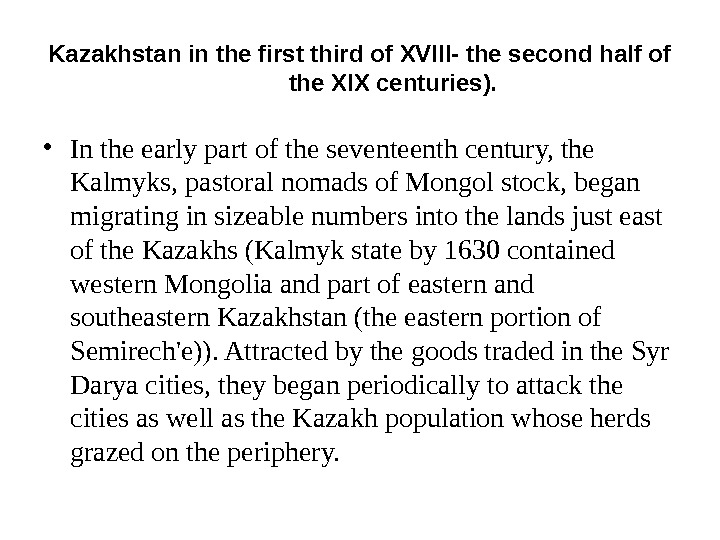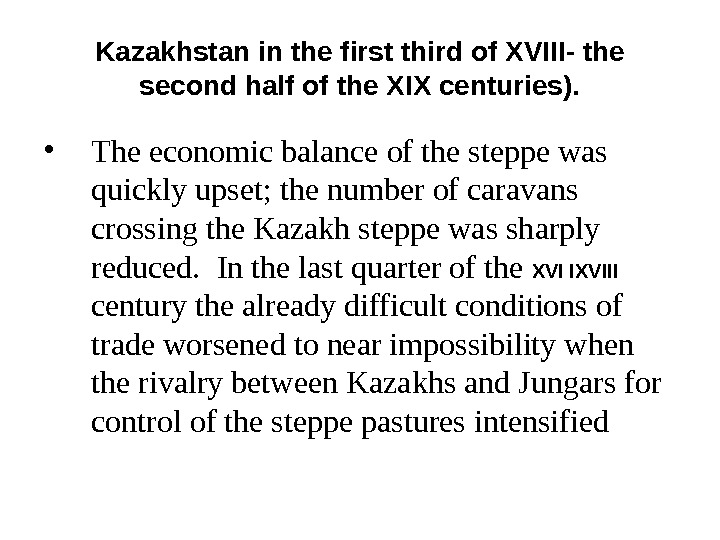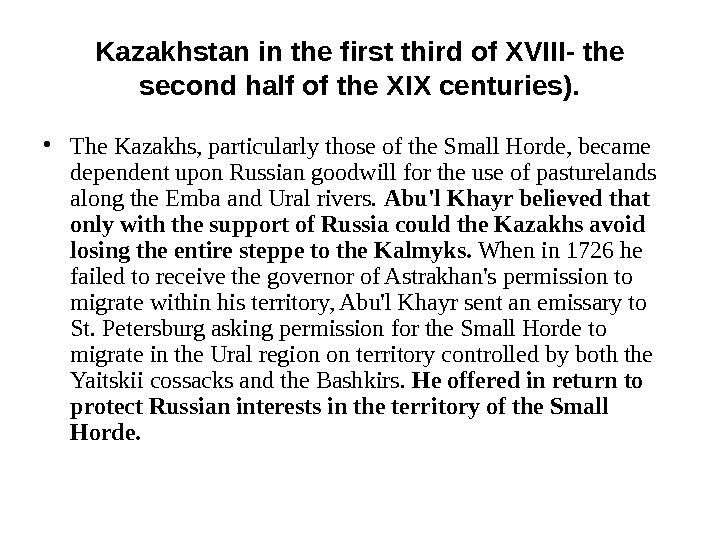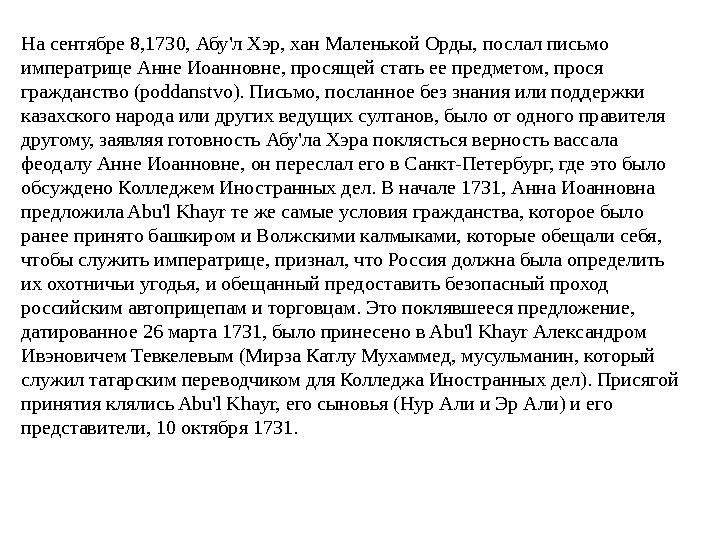Kazakhstan in the first third of XVIII- the













- Размер: 300 Кб
- Количество слайдов: 12
Описание презентации Kazakhstan in the first third of XVIII- the по слайдам
 Kazakhstan in the first third of XVIII- the second half of the XIX centuries). • In the early part of the seventeenth century, the Kalmyks, pastoral nomads of Mongol stock, began migrating in sizeable numbers into the lands just east of the Kazakhs (Kalmyk state by 1630 contained western Mongolia and part of eastern and southeastern Kazakhstan (the eastern portion of Semirech’e)). Attracted by the goods traded in the Syr Darya cities, they began periodically to attack the cities as well as the Kazakh population whose herds grazed on the periphery.
Kazakhstan in the first third of XVIII- the second half of the XIX centuries). • In the early part of the seventeenth century, the Kalmyks, pastoral nomads of Mongol stock, began migrating in sizeable numbers into the lands just east of the Kazakhs (Kalmyk state by 1630 contained western Mongolia and part of eastern and southeastern Kazakhstan (the eastern portion of Semirech’e)). Attracted by the goods traded in the Syr Darya cities, they began periodically to attack the cities as well as the Kazakh population whose herds grazed on the periphery.
 В начале семнадцатого столетия калмыки, пасторальные кочевники монгольского запаса, начали мигрировать в больших числах в земли просто к востоку от казахов (калмыцкое государство к 1630 содержало западную Монголию и часть восточного и юго-восточного Казахстана (восточная часть Semirech’e)). Привлеченный товарами торговал в городах Сыр Дарьи, они начали периодически нападать на города так же как казахское население, стада которого паслись на периферии.
В начале семнадцатого столетия калмыки, пасторальные кочевники монгольского запаса, начали мигрировать в больших числах в земли просто к востоку от казахов (калмыцкое государство к 1630 содержало западную Монголию и часть восточного и юго-восточного Казахстана (восточная часть Semirech’e)). Привлеченный товарами торговал в городах Сыр Дарьи, они начали периодически нападать на города так же как казахское население, стада которого паслись на периферии.
 A man who impacted the history
A man who impacted the history
 Kazakhstan in the first third of XVIII- the second half of the XIX centuries). • The economic balance of the steppe was quickly upset; the number of caravans crossing the Kazakh steppe was sharply reduced. In the last quarter of the XVI IXVIII century the already difficult conditions of trade worsened to near impossibility when the rivalry between Kazakhs and Jungars for control of the steppe pastures intensified
Kazakhstan in the first third of XVIII- the second half of the XIX centuries). • The economic balance of the steppe was quickly upset; the number of caravans crossing the Kazakh steppe was sharply reduced. In the last quarter of the XVI IXVIII century the already difficult conditions of trade worsened to near impossibility when the rivalry between Kazakhs and Jungars for control of the steppe pastures intensified
 Экономический баланс степи был быстро расстроен; количество автоприцепов, пересекающих казахскую степь, было резко сокращено. В последней четверти столетия XVIII уже трудные условия торговли ухудшились к близкой невозможности когда конкуренция между казахами и Jungars для контроля усиленных пастбищ степи
Экономический баланс степи был быстро расстроен; количество автоприцепов, пересекающих казахскую степь, было резко сокращено. В последней четверти столетия XVIII уже трудные условия торговли ухудшились к близкой невозможности когда конкуренция между казахами и Jungars для контроля усиленных пастбищ степи
 Kazakhstan in the first third of XVIII- the second half XIX centuries). • During this same period, the late XVII and early XVIII centuries, the Russian economy was expanding. The Statistiko-finansovaia kartina v 1698 -1700 godakh shows that one result of this expansion was increased trade with both Kazakhs and Kalmyks. However, pacification of the steppe was important less because of the potential of the Kazakhs as trading partners than as a necessary precondition for an expansion of Russian trade with Central Asia and with the markets of Persia and India.
Kazakhstan in the first third of XVIII- the second half XIX centuries). • During this same period, the late XVII and early XVIII centuries, the Russian economy was expanding. The Statistiko-finansovaia kartina v 1698 -1700 godakh shows that one result of this expansion was increased trade with both Kazakhs and Kalmyks. However, pacification of the steppe was important less because of the potential of the Kazakhs as trading partners than as a necessary precondition for an expansion of Russian trade with Central Asia and with the markets of Persia and India.
 Во время этого же самого периода, последнее XVII и рано XVIII столетий, расширялась российская экономика. Statistiko-finansovaia kartina v 1698 -1700 godakh показывает, что один результат этого расширения был увеличен торговля и с казахами и с калмыками. Однако, умиротворение степи было важно меньше из-за потенциала казахов как торговые партнеры, чем как необходимое предварительное условие для расширения российской торговли со Средней Азией и с рынками Персии и Индии.
Во время этого же самого периода, последнее XVII и рано XVIII столетий, расширялась российская экономика. Statistiko-finansovaia kartina v 1698 -1700 godakh показывает, что один результат этого расширения был увеличен торговля и с казахами и с калмыками. Однако, умиротворение степи было важно меньше из-за потенциала казахов как торговые партнеры, чем как необходимое предварительное условие для расширения российской торговли со Средней Азией и с рынками Персии и Индии.
 Kazakhstan in the first third of XVIII- the second half of the XIX centuries). • The Kazakhs, particularly those of the Small Horde, became dependent upon Russian goodwill for the use of pasturelands along the Emba and Ural rivers. Abu’l Khayr believed that only with the support of Russia could the Kazakhs avoid losing the entire steppe to the Kalmyks. When in 1726 he failed to receive the governor of Astrakhan’s permission to migrate within his territory, Abu’l Khayr sent an emissary to St. Petersburg asking permission for the Small Horde to migrate in the Ural region on territory controlled by both the Yaitskii cossacks and the Bashkirs. He offered in return to protect Russian interests in the territory of the Small Horde.
Kazakhstan in the first third of XVIII- the second half of the XIX centuries). • The Kazakhs, particularly those of the Small Horde, became dependent upon Russian goodwill for the use of pasturelands along the Emba and Ural rivers. Abu’l Khayr believed that only with the support of Russia could the Kazakhs avoid losing the entire steppe to the Kalmyks. When in 1726 he failed to receive the governor of Astrakhan’s permission to migrate within his territory, Abu’l Khayr sent an emissary to St. Petersburg asking permission for the Small Horde to migrate in the Ural region on territory controlled by both the Yaitskii cossacks and the Bashkirs. He offered in return to protect Russian interests in the territory of the Small Horde.
 Казахи, особенно те из Маленькой Орды, стали зависящими от российской доброжелательности для использования пастбищ вдоль рек Эмбы и Урала. Абу’л Хэр полагал, что только с поддержкой России мог казахи избегать терять всю степь калмыкам. Когда в 1726 он не принял губернатора разрешения Астрахани мигрировать в его территории, Абу’л Хэр послал эмиссара в санкт-петербургское разрешение выяснения для Маленькой Орды, чтобы мигрировать в Уральском регионе на территории, которой управляют и казаками Yaitskii и башкирами. Он предложил взамен защищать российские интересы на территории Маленькой Орды.
Казахи, особенно те из Маленькой Орды, стали зависящими от российской доброжелательности для использования пастбищ вдоль рек Эмбы и Урала. Абу’л Хэр полагал, что только с поддержкой России мог казахи избегать терять всю степь калмыкам. Когда в 1726 он не принял губернатора разрешения Астрахани мигрировать в его территории, Абу’л Хэр послал эмиссара в санкт-петербургское разрешение выяснения для Маленькой Орды, чтобы мигрировать в Уральском регионе на территории, которой управляют и казаками Yaitskii и башкирами. Он предложил взамен защищать российские интересы на территории Маленькой Орды.
 Kazakhstan in the first third of XVIII- the second half of XIX centuries). • On September 8, 1730, Abu’l Khayr, khan of the Small Horde, sent a letter to Empress Anna Ioannovna requesting to become her subject by asking for citizenship (poddanstvo). The letter, sent without the knowledge or support of the Kazakh people or the other leading sultans, was from one ruler to another, stating Abu’l Khayr’s willingness to swear fealty to Anna Ioannovna, he sent it on to St. Petersburg where it was debated by the College of Foreign Affairs. • In early 1731, Anna Ioannovna offered Abu’l Khayr the same terms of citizenship that had previously been accepted by the Bashkir and Volga Kalmyks, who had pledged themselves to serve the empress, accepted that Russia was to specify their hunting grounds, and promised to provide safe passage for Russian caravans and merchants. • This sworn offer, dated March 26, 1731, was brought to Abu’l Khayr by Aleksander Ivanovich Tevkelev (Mirza Kutlu Muhammad, a Muslim who served as Tatar translator for the College of Foreign Affairs). The accepting oath was sworn by Abu’l Khayr, his sons (Nur Ali and Er Ali) and his deputies, on October 10, 1731.
Kazakhstan in the first third of XVIII- the second half of XIX centuries). • On September 8, 1730, Abu’l Khayr, khan of the Small Horde, sent a letter to Empress Anna Ioannovna requesting to become her subject by asking for citizenship (poddanstvo). The letter, sent without the knowledge or support of the Kazakh people or the other leading sultans, was from one ruler to another, stating Abu’l Khayr’s willingness to swear fealty to Anna Ioannovna, he sent it on to St. Petersburg where it was debated by the College of Foreign Affairs. • In early 1731, Anna Ioannovna offered Abu’l Khayr the same terms of citizenship that had previously been accepted by the Bashkir and Volga Kalmyks, who had pledged themselves to serve the empress, accepted that Russia was to specify their hunting grounds, and promised to provide safe passage for Russian caravans and merchants. • This sworn offer, dated March 26, 1731, was brought to Abu’l Khayr by Aleksander Ivanovich Tevkelev (Mirza Kutlu Muhammad, a Muslim who served as Tatar translator for the College of Foreign Affairs). The accepting oath was sworn by Abu’l Khayr, his sons (Nur Ali and Er Ali) and his deputies, on October 10, 1731.
 На сентябре 8, 1730, Абу’л Хэр, хан Маленькой Орды, послал письмо императрице Анне Иоанновне, просящей стать ее предметом, прося гражданство (poddanstvo). Письмо, посланное без знания или поддержки казахского народа или других ведущих султанов, было от одного правителя другому, заявляя готовность Абу’ла Хэра поклясться верность вассала феодалу Анне Иоанновне, он переслал его в Санкт-Петербург, где это было обсуждено Колледжем Иностранных дел. В начале 1731, Анна Иоанновна предложила Abu’l Khayr те же самые условия гражданства, которое было ранее принято башкиром и Волжскими калмыками, которые обещали себя, чтобы служить императрице, признал, что Россия должна была определить их охотничьи угодья, и обещанный предоставить безопасный проход российским автоприцепам и торговцам. Это поклявшееся предложение, датированное 26 марта 1731, было принесено в Abu’l Khayr Александром Ивэновичем Тевкелевым (Мирза Катлу Мухаммед, мусульманин, который служил татарским переводчиком для Колледжа Иностранных дел). Присягой принятия клялись Abu’l Khayr, его сыновья (Нур Али и Эр Али) и его представители, 10 октября 1731.
На сентябре 8, 1730, Абу’л Хэр, хан Маленькой Орды, послал письмо императрице Анне Иоанновне, просящей стать ее предметом, прося гражданство (poddanstvo). Письмо, посланное без знания или поддержки казахского народа или других ведущих султанов, было от одного правителя другому, заявляя готовность Абу’ла Хэра поклясться верность вассала феодалу Анне Иоанновне, он переслал его в Санкт-Петербург, где это было обсуждено Колледжем Иностранных дел. В начале 1731, Анна Иоанновна предложила Abu’l Khayr те же самые условия гражданства, которое было ранее принято башкиром и Волжскими калмыками, которые обещали себя, чтобы служить императрице, признал, что Россия должна была определить их охотничьи угодья, и обещанный предоставить безопасный проход российским автоприцепам и торговцам. Это поклявшееся предложение, датированное 26 марта 1731, было принесено в Abu’l Khayr Александром Ивэновичем Тевкелевым (Мирза Катлу Мухаммед, мусульманин, который служил татарским переводчиком для Колледжа Иностранных дел). Присягой принятия клялись Abu’l Khayr, его сыновья (Нур Али и Эр Али) и его представители, 10 октября 1731.
 Kazakhstan in the first third of XVIII- the second half of XIX centuries). • The agreement was mutually advantageous. To Abu’l Khayr it offered the possibility of improving his political position as well as of increasing economic stability, for the Kazakhs and their neighbors saw that Russia was the superior military force in the region. • Stability was crucial, for the economy of the Small Horde was in ruin. Abu’l Khayr, his followers, and their herds—some 100, 000 households or 400, 000 people—had been driven from Turkestan, moving from the Syr Darya river region to pasturelands in the Ural and Tobol river regions. During this time many thousands of cattle were killed. • Abu’l Khayr also had a powerful rival for control of the Small Horde in the person of Sultan Qayip (Kaip); • Anna Ioannovna was both aware of this rivalry and prepared to exploit it, for she knew that Abu’l Khayr (and his heirs) needed the stability provided by an alliance with Russia to remain in power. • For Russia’s part, the treaties with Abu’l Khayr and those with the khans of the Middle Horde (Semeke in 1732, Ablai in 1740) gave added security to the fortified line along the Irtysh River.
Kazakhstan in the first third of XVIII- the second half of XIX centuries). • The agreement was mutually advantageous. To Abu’l Khayr it offered the possibility of improving his political position as well as of increasing economic stability, for the Kazakhs and their neighbors saw that Russia was the superior military force in the region. • Stability was crucial, for the economy of the Small Horde was in ruin. Abu’l Khayr, his followers, and their herds—some 100, 000 households or 400, 000 people—had been driven from Turkestan, moving from the Syr Darya river region to pasturelands in the Ural and Tobol river regions. During this time many thousands of cattle were killed. • Abu’l Khayr also had a powerful rival for control of the Small Horde in the person of Sultan Qayip (Kaip); • Anna Ioannovna was both aware of this rivalry and prepared to exploit it, for she knew that Abu’l Khayr (and his heirs) needed the stability provided by an alliance with Russia to remain in power. • For Russia’s part, the treaties with Abu’l Khayr and those with the khans of the Middle Horde (Semeke in 1732, Ablai in 1740) gave added security to the fortified line along the Irtysh River.

